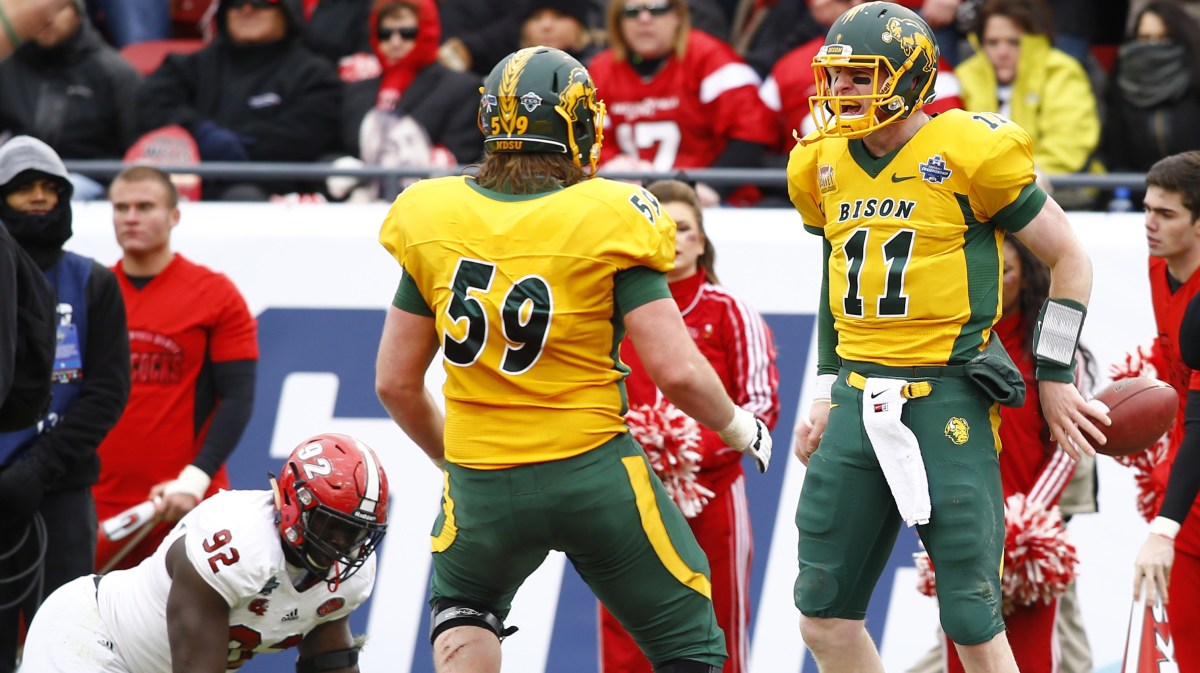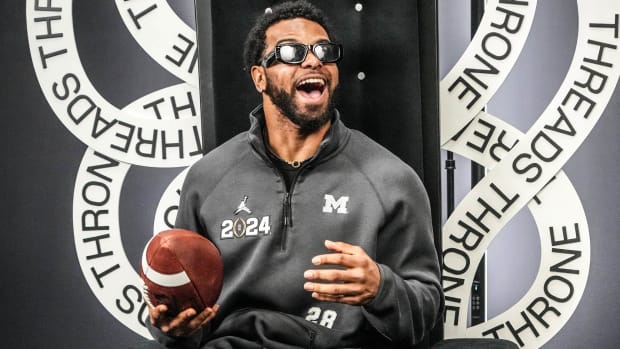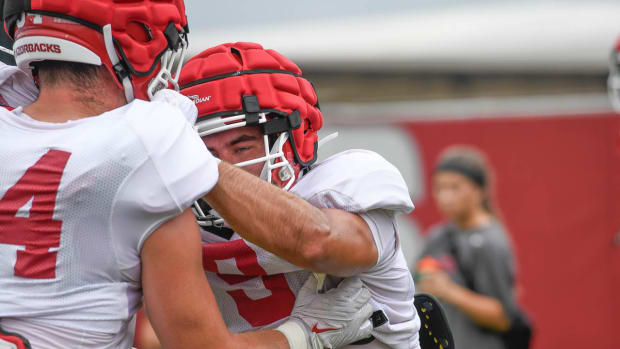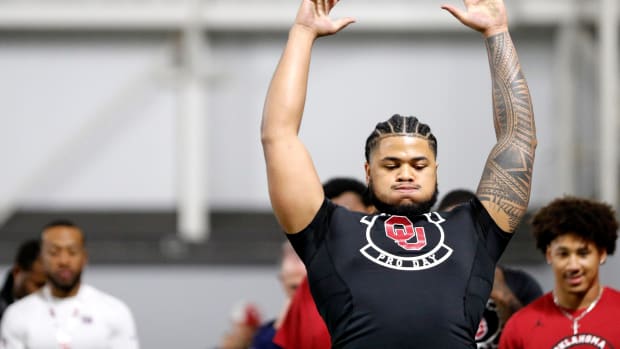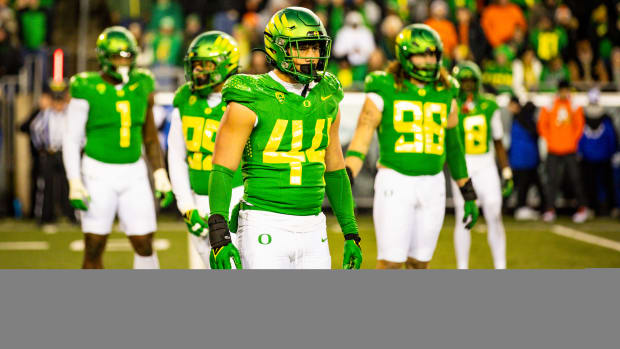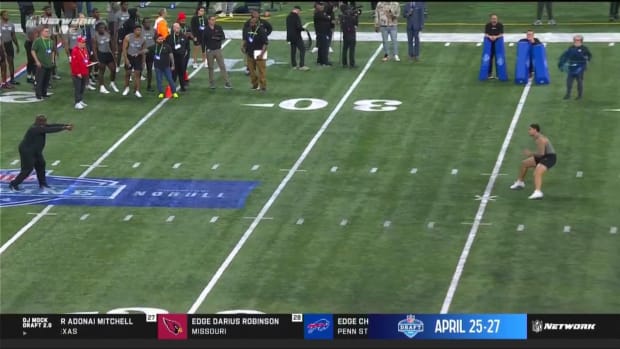NFL Draft: FCS offensive players to know
(STATS) - An average of about 18 players from the FCS level have been selected in the NFL Draft in recent years.
Beginning with North Dakota State quarterback Carson Wentz early in the first round - at No. 1, No. 2? - there are plenty of talented FCS players in the mix this year.
Following are offensive players to know for the seven-round draft, which will be held April 28-30 in Chicago:
---=
Ben Braunecker, TE, Harvard, 6-4, 240 (6th-7th round possibility)=
"Ben is perhaps the most explosive and athletic tight end we have had at Harvard, including three guys who have signed NFL contracts in the past three years." Certainly high praise from Crimson coach Tim Murphy. With a major in molecular and cellular biology, Braunecker also might be the smartest. A three-year starter and team captain as a senior in high school, Braunecker improved in each of his three seasons at Harvard, capping it off with 48 catches for 850 yards and eight touchdowns in 2015. His receiving yards ranked sixth-most for a single season in school history, and he garnered various first-team All-America honors, including with STATS. After a relatively slow start to the season, he finished with 39 receptions in his last six games, four of which were for over 100 yards. A participant in the NFLPA Collegiate Bowl, Braunecker is a physical tight end who is not afraid to go toe-to-toe when blocking. He certainly has the tools to reach the next level and is hoping to join the list of the last four Crimson players to reach the NFL who had decent success (Matt Birk, Isaiah Kacyvenski, Ryan Fitzpatrick and Kyle Juszczyk).
---=
Marshaun Coprich, RB, Illinois State, 5-9, 205 (7th round)=
A finalist for STATS FCS Offensive Player of the Year, finishing third to Cooper Kupp, Coprich had a sensational senior season, rushing for just under 2,000 yards and scoring 24 touchdowns. In fact, he rushed for over 100 yards 10 times in 2015, which included three consecutive 200-yard games. His career numbers at Illinois State were remarkable: 5,196 rushing yards and 60 scores to go with 33 catches, including 18 this past season. Coprich fashions himself in the mold of Barry Sanders and has earned the nickname "Young Bull." The two-time Missouri Valley offensive player of the year also earned All-America honors from STATS. Although his numbers are against the so-called lower division in college football, Coprich does have the stamina to carry the load and averaged 25 carries per game last year. Maturity is something Coprich has worked hard on and that should carry him into the NFL. Prior to the start of his final season, he was arrested and initially suspended from the team for selling marijuana to an undercover police officer. As a first-time offender, he received two years of probation. His NFL Combine totals were solid, running a 4.47 in the 40-yard dash and posting a 34-inch vertical jump. Size certainly matters in the NFL, but Coprich might break that stigma.
---=
Clay DeBord, OT, Eastern Washington, 6-6, 305 (7th round-priority free agent)=
He started the 2015 season as a third-team STATS FCS All-American, which by most accounts is pretty good. That certainly wasn't good enough for DeBord, who finished his senior year as a first-team selection of STATS, The Associated Press, College Sporting News and, of course, the Big Sky Conference. Over his career at Eastern Washington, DeBord played in 52 games, starting a school-record 51, and finished his tenure with a performance in the NFLPA Collegiate Bowl. With enough size to compete in the NFL, DeBord was part of an offensive line for the Eagles that was coached by offensive coordinator Aaron Best and led the FCS in passing offense at 353.3 yards per game and ranked eighth in total offense. As FCS offensive tackles go, DeBord is the second-highest behind North Dakota State's Joe Haeg and Harvard's Cole Toner. There are plenty of studs ahead of him on the depth chart, so if he fails to get drafted in the late rounds, look for several teams to try to sign him as a free agent.
---=
Anthony Fabiano, C, Harvard, 6-5, 290 (7th round-priority free agent)=
Sporting News has called Fabiano the "NFL Draft's most athletic lineman." Having played tight end in high school, Fabiano was athletic enough to play different positions on Harvard's offensive line, but he is expected to be a center in the NFL. He was named to the All-Ivy League first team as a senior despite having his season end prematurely after he suffered a hyperextended toe, a torn toe tendon and a fractured bone in his right foot against Dartmouth on Oct. 30. Surgery in December eliminated him from playing in a postseason all-star game and participating at the NFL Combine, but he rehabilitated himself for Harvard's pro day. He posted results that rivaled the best for offensive linemen at the Combine, including a 4.94-second 40-yard dash. Fabiano plays with a nasty side, but needs to increase his core strength, so he's added quality weight in the buildup to the draft. While Fabiano was part of Harvard's Ivy League championship squads in 2011, '13, '14 and '15, he also missed five games in 2013 because of a broken hand.
---=
Joe Haeg, OT, North Dakota State, 6-6, 310 (3rd-4th round)=
When you're big, you get noticed. When you play for five-time defending FCS national champion North Dakota State, you really get noticed. That certainly is the case with Haeg. The offensive lineman, who was invited to the NFL Combine and Senior Bowl, finished 13th in the voting for STATS FCS Offensive Player of the Year and the All-America first team. Haeg was barely recruited out of high school due to his lack of size, but that changed when he walked on at NDSU, where he added 70 pounds in his five years with the Bison. He also moved from right to left tackle after former teammate Billy Turner was drafted by Miami in 2014. Following a redshirt season, Haeg earned a starting spot in 2012 and finished his career with 60 starts in 61 games. The constant notion that FCS players rarely stack up in the NFL is ludicrous, and Haeg is expected to be among the latest to prove doubters wrong. Although the first round is likely out of the question, look for several teams, including the New England Patriots and Tennessee Titans, to keep their eyes on Haeg in the early rounds.
---=
Temarrick Hemingway, TE, South Carolina State, 6-5, 210 (7th round)=
At the NFL Combine, Hemingway posted the second-fastest 40-yard dash amongst tight ends at 4.71 seconds, ahead of players from UCLA, Stanford and North Carolina State. Hemingway, who was named to the Mid-Eastern Athletic Conference first team in back-to-back seasons, had a stellar career at South Carolina State with 91 receptions for over 1,000 yards and seven touchdowns, including 38 receptions in 2015. Over the past three seasons, he has started and played in all 35 games for the Bulldogs. His size is ideal for the position, although he could stand to gain a few pounds of muscle. His rock-solid frame and outstanding pass-catching prowess can make him a compelling target for any NFL quarterback. In addition, his blocking technique at the FCS level has been lauded by his coaches, but he will need to step that up against the top echelon in the NFL. Selected to play in the NFLPA Collegiate Bowl, Hemingway saw limited action and caught one pass for seven yards. If he continues to improve his pass routes and adds additional weight as he has done the past three years, then a call from an NFL team is highly likely, albeit in the late rounds of the draft.
---=
Lavaedeay "Vad" Lee, QB, James Madison, 6-1, 225 (7th round-PFA)=
A likely draftable candidate until he suffered a broken foot in late October, Lee has perhaps fallen out of that prospect. Until the injury during James Madison's eighth game, the Dukes had not lost a game and were ranked as high as No. 4 in the FCS. Lee did enough before the injury, however, for him to earn the CAA Football offensive player of the year award after the regular season. He began his college career as an option-style quarterback under coach Paul Johnson at Georgia Tech and made starts over two seasons, but he sought a transfer to play in a more pro-style attack, which he found in the JMU spread. He's equally strong lining up behind center as he is in a shotgun and sees the field well, using his foot speed to gain yardage on delayed draws and scrambles. But he needs to deliver the ball quicker before the pocket collapses. In a September victory over SMU, Lee became the first quarterback in Division I history to surpass both 275 yards passing and rushing in a game. He tied JMU's all-time record for touchdown passes (51) and had 7,292 total yards in only 21 career games. Improving his arm strength was a must, and Lee says that was his focus during his recovery period. But the injury occurred at a bad time, causing him to miss the all-star game circuit and NFL scouting combine.
---=
Paul McRoberts, WR, Southeast Missouri State, 6-3, 197 (6th-7th round)=
Considered the best FCS wide receiver in the 2016 class, McRoberts departed Southeast Missouri as one of its more accomplished receiving threats. The three-year starter's 29 touchdown catches set a program record and his 2,435 receiving yards ranked third. His past basketball career, which included one season in college, reflects his ability to high point the ball and win close one-on-one matchups. His 33 1/2-inch arm length aids to his success in the red zone. He needs to put on weight and be faster in breaking off routes, but McRoberts displays excellent vision and elusiveness with the ball. He caught 76 passes for 940 yards and nine touchdowns as a senior, often taking off after short receptions. McRoberts was named to the All-Ohio Valley Conference first team in each of his final two seasons. He also caught four passes and a touchdown and played well on special teams in the Senior Bowl. Still, there are concerns regarding the next level. He suffered a Lisfranc injury to cut his junior season by five games and will be 24 years old in his rookie season. Not a burner, he will have to work harder to get off the line of scrimmage and beat the many faster cornerbacks in the NFL.
---=
Beau Sandland, TE, Montana State, 6-6, 260 (7th round-PFA)=
The need for versatile, athletic tight ends has increased steadily in the NFL and Sandland's stock has risen in the draft buildup - his style seemingly coming from the mold of the late-developing Julius Thomas, who entered the NFL out of the Big Sky Conference at Portland State. Sandland is well-traveled, having gone from being a junior college standout at Pierce College to a backup at Miami (Fla.) to sitting out 2014 as a transfer and then finishing as an FCS All-American at Montana State. He caught 37 passes for 632 yards and nine touchdowns as a senior in his only season with the Bobcats. His chief attribute is his athleticism and it reflects in the necessary measurables for today's prototypical tight end, including a 10 1/8-inch hand-span, 34 1/4-inch arm length and a 4.74 time in the 40-yard dash at the NFL Combine. Sandland is adept at separating at the line of scrimmage and getting downfield for over-the-top passes. He is noted for having soft hands as well. While inconsistent as a run blocker, he has concentrated on improving his hand placement. He played in the NFLPA Collegiate Bowl following his senior season.
---=
Cole Toner, OT, Harvard, 6-7, 300 (5th-6th round)=
Harvard isn't thought of as a pipeline to the NFL, but the Crimson boasted six alumni in the league last season. Toner is next in line. He dominated Ivy League competition throughout his career, starting all but the first four games of his freshman season. It's now a matter of being able to handle NFL-caliber defenders. He received a look at the next level during Senior Bowl week, where players were bigger, stronger and faster than he's been accustomed to facing, and he had both positive and negative results. His body type (broad shoulders, trim midsection) is athletic and suggests room for growth, and he has a high football IQ, not unexpected considering his background. On run blocking, he's been able to push defenders back off the line of scrimmage. In pass protection, he's had a cerebral approach to deliver a punch at the right time. He was on the All-Ivy first team twice and, as a senior, made the FCS All-America first team. Toner's rookie season might be more of a developmental year as he tries to increase his strength, but he's clearly a legitimate mid-round prospect.
---=
Carson Wentz, QB, North Dakota State, 6-5, 237 (1st round)=
It's not considered an outstanding year for draft-bound quarterbacks coming from the FBS, which helps explain why there's been so much talk about Wentz going early, presumably in the top two picks. But the starter on North Dakota State's two most recent FCS national championship teams (out of a record five straight) also has legitimate talent, which previously was hidden by the small-school label. Wentz has prototypical size for the NFL and looks at ease in running an offense. His 4.0 GPA throughout college reflects his heady style of play. He has the 10-inch hand size favored by NFL teams. His mechanics and throwing motion are clean, and he is very good in delivering passes with both velocity and touch. He threw for 6,143 yards and 59 touchdowns in his NDSU career, mostly over his junior and senior seasons. Interceptions weren't a problem for him, but Wentz has a propensity to stare down his desired target and not go through progressions quickly enough. Despite his size, he will make plays with his feet. He can get away from defenders taking poor angles and will eat up yardage, but his NFL team will want him to be more conservative than trying to power through defenders, which he did in college. He missed eight games as a senior with a broken bone in his throwing wrist, but he looked healthy when he returned for the national championship game and then participated at the Senior Bowl and the NFL Combine. He only started 23 games in college - fewer than a typical Top 10 candidate - and only one was against an FBS team. Jared Goff of Cal might surpass Wentz as the first quarterback selected in the draft, but Wentz is expected to be just the fifth non-FBS signal caller to go in the first round, and the first since Joe Flacco went to the Baltimore Ravens with the 18th pick in 2008. From there, Wentz will be asked to eventually become a franchise quarterback.
---=
Torian White, OT, Hampton, 6-6, 335 (7th round-PFA)=
The small-school Mid-Eastern Athletic Conference often has at least one player drafted, and White is a candidate in a pretty solid year for the FCS conference, which expects to have multiple selections. If drafted, he would go in a later round. White was highly regarded coming out of high school and began his career at UCLA. He started 14 games as a redshirt freshman in 2012 when running back Johnathan Franklin had a record-setting season. As a sophomore, White suffered a season-ending broken ankle and ligament tear in the fourth game. But he never played for the Bruins again. In the spring of 2014, he was dismissed from the program after the university found him responsible for two instances of sexual misconduct. Having transferred to Hampton, he salvaged his playing career and finished strong, gaining MEAC honors as a senior and helping the Pirates to their first winning season since 2011. He was invited to the NFLPA Collegiate Bowl afterward. With a versatile skill set, White can adapt to different spots on the offensive line and he may switch from tackle to guard at the next level. In addition to the ankle injury, White's medical history includes undergoing a procedure in 2012 to fix a problem with his heart rhythm.
---=
Josh Woodrum, QB, Liberty, 6-3, 231 (7th round)=
A four-year starter under coach Turner Gill at Liberty, Woodrum finished his career as the Flames' all-time leader in passing yards (10,266), total yards (10,690), completions (833) and attempts (1,304), and was second in touchdown passes (61) and completion percentage (63.9). He had six of his 14 career 250-yard games as a senior. Woodrum displays excellent leadership with a strong football IQ. He is durable and steady, though not spectacular. Built with an athletic body and willing to stand tall in the pocket, Woodrum has good arm strength to drive passes upfield. He will pump-fake on throws to pause the defense. Woodrum rushed for 16 touchdowns in his career, but he is not adept on getting out on the run. He needs to improve his footwork and is prone to reacting too late while facing pressure in the pocket. Woodrum was named the 2012 Big South freshman of the year and earned all-conference second-team honors in each of his final three seasons. He played in the NFLPA Collegiate Bowl. If Woodrum isn't a late-round selection on day 3 of the NFL Draft, he will be scooped up quickly as a priority free agent.
